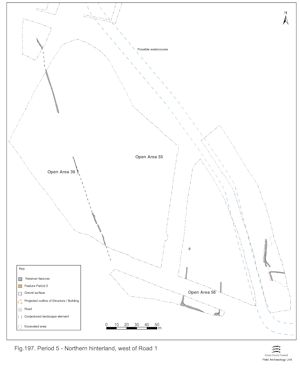
No features are identified as being created within the Northern Hinterland in this Late Roman period (Figure 197), though it is possible that some of the Period 4 boundary features, particularly north-to-south ditch 25187, and perhaps the ditches of sub-enclosure OA54 (25193/25194 etc.), survive for some time. Tentative minor re-cuts are occasionally identified (e.g. 2306, 2308, 2312), but it is more likely that the long-since silted up ditches simply acquire later material in their tops/slump hollows, possibly accumulating under the shelter of hedges that perpetuate the earlier divisions of the Northern hinterland (e.g. Period 4 re-cut of ditch 25188).

It is difficult to know what conclusions can legitimately be drawn from this lack of new additions to the landscape layout. Are all the earlier land divisions abandoned and the terrain allowed to revert to one undivided block? This perhaps fits with a common theory about the nature of later Roman farming, especially in East Anglia, envisaging a landscape of huge open ranch ranges. But need the fact that there were no new ditches being created necessarily mean the landscape is undivided? And need the open spaces be grassland? Woodland regeneration is another possibility, perhaps.
No Late Roman remains occupy the remnants of this landscape; even pitting is absent. As such, it seems unnecessary to describe and discuss each of the former open areas. The plot bounded by ditches 25187 and 25189 may retain some meaning as an entity, though this can only be inferred from its later (Period 6) apparent occupation.
Internet Archaeology is an open access journal based in the Department of Archaeology, University of York. Except where otherwise noted, content from this work may be used under the terms of the Creative Commons Attribution 3.0 (CC BY) Unported licence, which permits unrestricted use, distribution, and reproduction in any medium, provided that attribution to the author(s), the title of the work, the Internet Archaeology journal and the relevant URL/DOI are given.
Terms and Conditions | Legal Statements | Privacy Policy | Cookies Policy | Citing Internet Archaeology
Internet Archaeology content is preserved for the long term with the Archaeology Data Service. Help sustain and support open access publication by donating to our Open Access Archaeology Fund.